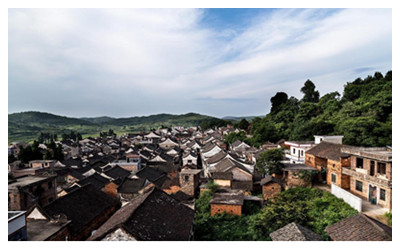
Miaoxia Ancient Village
What to see ?
Forbidden Steles
 In the village stand some forbidden steles recording the village stipulations that villagers should abide by. For example, on a stone pillar of a pavilion engraved signs like "No dumping or iron striking allowed" and "No farm cattle killing allowed". On a stele near an ancient well in Xianfeng Township of Rucheng County carved the sign of "No washing of vegetables or dirty objects allowed".
In the village stand some forbidden steles recording the village stipulations that villagers should abide by. For example, on a stone pillar of a pavilion engraved signs like "No dumping or iron striking allowed" and "No farm cattle killing allowed". On a stele near an ancient well in Xianfeng Township of Rucheng County carved the sign of "No washing of vegetables or dirty objects allowed".
Ancient Houses
The dwelling houses dated back to the Ming (1368-1644) and Qing (1644-1911) dynasties in Miaoxia Village are almost the same, showing no typical rich families then. The only slight difference lies in the building style, with houses of the Ming Dynasty simpler while those of the Qing Dynasty fancier and more delicate. But even the fanciness has now become less gaudy after hundreds of years.
The ancient dwelling houses of the village stand side by side. If observing them carefully, you will find the blue bricks of the houses polished and well-arranged in straight lines. Different from the residences in Shiquan County of Shaanxi Province, roofs of the houses in Miaoxia Village are in the shape of horse heads curving upward, a typical architectural style in southern Hunan. The inner rooms of these houses bear the same delicate styles and reveal their similar historical experiences.
Stepping into an ordinary square courtyard, you will find delicately carved ornamentation on gates, stone tablets, wainscots, column bases, dougong (part of the network of wooden supports essential to the timber frame structure of traditional Chinese building), folding screens, traceries and door lintels, tile carving on firewalls and cornices, stone carving on courtyards and stone steps, and wood carving on doors, windows and folding screens. Those vivid character and animal carvings indicate favorable circumstances and good luck. Each totem conveys an artistic conception and series of carvings tell people different stories.
Watched from outside, the village appears a little disorderly. Walking through new houses at the edge of the village, it seems like you exist in different space and time upon arriving at a large half-moon shaped pond at the center of the village.Stepping down into the lane of the village, you feel yourself falling into a labyrinth. It takes you a long time to cover only a short length of the lane. Flagstone walks meet one another, surrounded by silent households. Grandmas sit on chairs in the sun, chitchatting with each other. Neighboring kids even play basketball here in the lane occasionally.
The survival of so many ancient villages in southern Hunan mainly results from inconvenient transportation and poverty there. But this also owes to the influence of the local culture. For example, people inhabiting those villages almost belong to the same clan. Every village has built its ancestral halls where villagers get together to watch operas or to attend ancestral sacrificial ceremonies. This represents the cohesion of a clan which is the inner cause leading to the existence of such ancient villages for hundreds of years.






 Ask Questions ?
Ask Questions ?